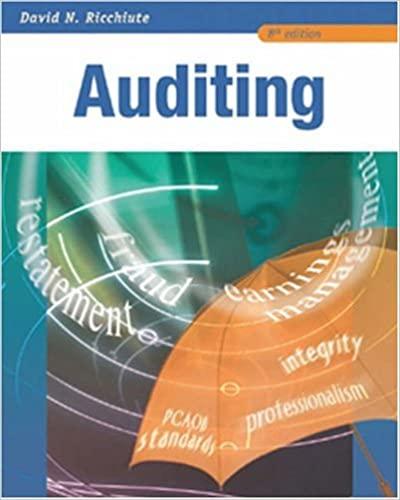Question
Following is a series of independent cases . In each situation, indicate the cash distribution to be made at the end of the liquidation process.
| Following is a series of independent cases. In each situation, indicate the cash distribution to be made at the end of the liquidation process. Unless otherwise stated, assume that all solvent partners will reimburse the partnership for their deficit capital balances. |
| a. | The Simon, Haynes, and Jackson partnership presently reports the following accounts. Jackson is personally insolvent and can contribute only an additional $7,000 to the partnership. Simon is also insolvent and has no available funds. |
| Cash | $ 41,000 |
| Liabilities | 33,000 |
| Haynes, loan | 32,000 |
| Simon, capital (40%) | 27,000 |
| Haynes, capital (20%) | (17,000) |
| Jackson, capital (40%) | (34,000) |
|
| b. | Hough, Luck, and Cummings operate a local accounting firm as a partnership. After working together for several years, they have decided to liquidate the partnership's property. The partners have prepared the following balance sheet: |
| Cash | $ 31,000 | Liabilities | $ 38,000 |
| Hough, loan | 19,000 | Luck, loan | 24,000 |
| Noncash assets | 184,000 | Hough, capital (50%) | 123,000 |
| Luck, capital (40%) | 23,000 | ||
| Cummings, capital (10%) | 26,000 | ||
| Total assets | $234,000 | Total liabilities and capital | $234,000 |
| The firm sells the noncash assets for $91,000; it will use $32,000 of this amount to pay liquidation expenses. All three of these partners are personally insolvent. Allocation based on 50:40:10 for Hough, Luck and Cummings capital respectively. |
|
| c. | Hough, Luck, and Cummings operate a local accounting firm as a partnership. After working together for several years, they have decided to liquidate the partnerships property. The partners have prepared the following balance sheet: |
| Cash | $ 31,000 | Liabilities | $ 38,000 |
| Hough, loan | 19,000 | Luck, loan | 24,000 |
| Noncash assets | 184,000 | Hough, capital | 123,000 |
| Luck, capital | 23,000 | ||
| Cummings, capital | 26,000 | ||
| Total assets | $234,000 | Total liabilities and capital | $234,000 |
| Assume that the profits and losses are split 2:4:4 to Hough, Luck, and Cummings, respectively, and that liquidation expenses are only $17,000. The firm sells the noncash assets for $91,000; All three of these partners are personally insolvent. (Do not round intermediate calculations. ) |
|
| d. | Following the liquidation of all noncash assets, the partnership of Redmond, Ledbetter, Watson, and Sandridge has the following account balances: |
| Liabilities | $ 35,000 |
| Redmond, loan | 16,000 |
| Redmond, capital (20%) | (43,000) |
| Ledbetter, capital (10%) | (41,000) |
| Watson, capital (30%) | 7,000 |
| Sandridge, capital (40%) | 26,000 |
| Redmond is personally insolvent. |
Redmond Loan Capital Ledbetter Capital Watson Capital Sandridge Capital
Beginning Balances
Allocation of Redmond's deficient balance
Capital Balance
Contribution by Ledbetter and Watson
Final Distribution
Step by Step Solution
There are 3 Steps involved in it
Step: 1

Get Instant Access to Expert-Tailored Solutions
See step-by-step solutions with expert insights and AI powered tools for academic success
Step: 2

Step: 3

Ace Your Homework with AI
Get the answers you need in no time with our AI-driven, step-by-step assistance
Get Started


